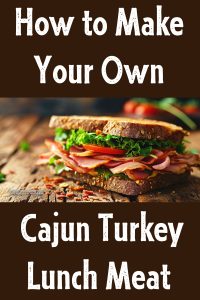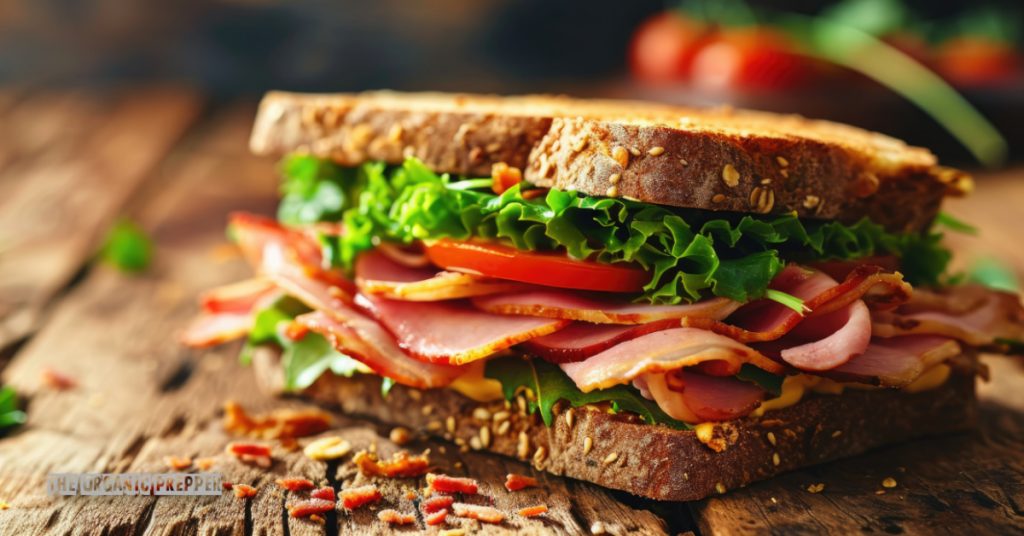If you're new here, you may want to subscribe to my RSS feed. Thanks for visiting!
In a previous article, How to Make Your Own Lunch Meat, we made a garlic, onion and herb roast beef. As I promised, now we’re making a Cajun-seasoned roasted turkey lunch meat.
Meat Selection and the Power of Salt
I was looking for a boneless, skinless turkey breast but did not find one. It must be a Thanksgiving thing. I did find a bone-in, skin-on, frozen turkey breast at $18.42 for 6.16 lbs.

Again, using the book Charcuterie: The Craft of Salting, Smoking, and Curing by Michael Ruhlman and Brian Polcyn, I made a basic brine. I highly recommend this book for your own library.
Brining meat does three things:
1) It changes the meat cells at the molecular level, allowing the cells to plump with water, thereby making the meat moist. You can do the same thing with a whole turkey to prevent it from becoming dry at Thanksgiving dinner. I have done that in the past.
2) It infuses whatever seasoning or flavors you want to add. I made the above-mentioned Thanksgiving turkey with an Earl Grey tea infusion. It turned out great!
3) The salt acts as a preservative, preventing bacteria from forming in the short term, more so than unbrined meat.
Here’s the step by step for making turkey lunch meat.
The basic brine is:
- 1 gallon/4 liters of water
- ¾ cup/200 grams of kosher salt
- ½ cup/125 grams of sugar
I took half a gallon of water, put it in a bowl, and put it in the freezer to chill while I made the brine.
I put the other half of a gallon of water into a large sauce pan, mixed in the salt and sugar, and brought it to a boil, occasionally stirring until all the salt and sugar dissolved. I let it cool until just warm.
I then took the turkey breast and put it in a 2.5-gallon plastic zip-lock bag. I added the chilled water, then the Cajun seasoning, and then the warm brine. I secured the bag and placed it in the fridge. I used the charcuterie book’s guidelines for brining a 4 lb chicken and a full 15 lb turkey and split the difference of 18 hours. I drained and discarded the brine, rinsed the turkey breast, and then let it rest in the fridge for three hours.
Pre-heat the oven to 325 degrees.
While the oven was pre-heating, I cut the skin away, exposing the breast, leaving the skin on by the base of the back at the bottom next to the bottom of a cast iron roasting pan. Save that and the turkey carcass for later to make a very interesting stock. Never let anything go to waste! I used the Creole seasoning blend and packed it around the breast, down into the cavity and some around the skin.
Roast in the oven for 2 ¼ to 2 ½ hours or when the breast reads 165 degrees, not touching bone, on an instant read thermometer.
How Did It Come Out?
The Creole seasoning did make the surface of the breast a bit salty, but not unpleasantly so. The meat in the center, with no Creole seasoning, was moist and had a nice mild Cajun flavor. It was awesome!
Once cool, I put it in a bowl in the fridge as I had other things to do. Later, when I went into the fridge for something, I found my wife had been snacking, stripping off the top layers. It was so good, and she is not usually a fan of Cajun-like seasoning.
I cut the breast away from the bone, divided them into three different portions, wrapped them, and put them in the freezer for later use.
Up next, I am pondering the idea of a Jamaican Jerk chicken breast wrapped in bacon. If I could have found a boneless, skinless turkey breast as my original intent, I would have wrapped it in bacon, but no joy.
If you have any suggestions and would like to see me give it a go, I would love to hear them in the comments section!
About 1stMarineJarHead
1stMarineJarHead is not only a former Marine, but also a former EMT-B, Wilderness EMT (courtesy of NOLS), and volunteer firefighter.
He currently resides in the great white (i.e. snowy) Northeast with his wife and dogs. He raises chickens, rabbits, goats, occasionally hogs, cows and sometimes ducks. He grows various veggies and has a weird fondness for rutabagas. He enjoys reading, writing, cooking from scratch, making charcuterie, target shooting, and is currently expanding his woodworking skills.
















Sounds good, another option is to inject some of the brine to add flavor through out. I make “Canadian Bacon” which starts with pork loin brined for 4-5 days then smoked with fruit wood at 250 degrees to a temp of 160 degrees wrap rest in the refrigerator over night then slice and vacuum seal. Another is “Porkstrami” which is a boneless pork butt brined in a corned beef brine for 7 days then pushed into a cooking net and coated in pastrami spices and smoked with apple wood to 170 internal, then cooled and sliced. In the cooking mesh it makes it round like a sandwich meat. Just some other ideas for you, the “Canadian bacon” is popular with the locals, makes killer BLT’s.
For your “Porkstrami,” do you use your own corned beef brine, or a store bought one?
Thank you for the additional suggestions!
Thank you for sharing this. I have turkey breast on my grocery list. I’ve been thinking the same thing. Make your own and you know what is in it.
I’ve made chicken lunch meat. Grind up chicken breast, salt, and beef gelatin in the blender. Shove it into a Ham Maker round meat press. I cooked it in the Instant Pot, chilled overnight, and sliced it up on my slicer. You can add seasonings to your preference. I’ve made the pork loin ‘Canadian Bacon’ too. I liked that. So much savings from the local deli and you control the ingredients.
Thank you for your input about the meat press. Kate in my first article about making lunch meat asked if anyone had experience with a meat press.
I am fortunate enough to have a Costco less than a 30 minute drive from the principal residence. I purchase whole pork bellies there, cure and smoke my own bacon. Initially I followed the ideas in the charcuterie book mentioned. The curing time (7 days) made a product that was too salty for my 74 year old palate. About 3-4 days worked fine for me. Using a simple cure of dark brown sugar, Kosher salt and “pink” curing salt gave me a very good result using hickory and cherry in the smoker.
I can get whole pork loin. For Steve L, or anyone: What brining / curing mix do you use for the Canadian Bacon ?
Footnote: I always strip the bark off the wood for smoking. The bark contains tannins that can make your product bitter.
Thanks to 1stMarineJarhead for another great article !
Marc M